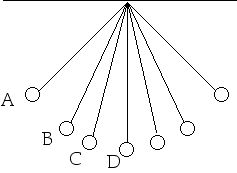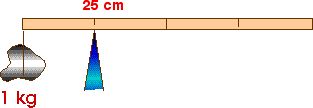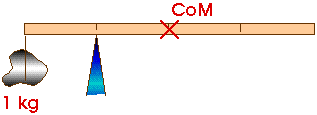

PHY 3050C
Excursions in Physics
Second Hour Exam
March 1, 2002
![]()
![]()
Enter all your answers in the "scantron sheet" or the "bubble
sheet". Turn in only that sheet. Anything you write on this exam will not
be seen or used or considered or graded. Be sure your name is on the "bubble
sheet" you hand in. Be sure your name is bubbled-in. Be sure your answers
are recorded correctly.
Possibly useful information:
| v = |
a = |
| v = vi + a t | x = xi + vi t + (1/2) a t2 |
| v = r |
|
| F = m a | F12 = – F21 |
| w = mg | g = 9.8 m/s2 |
| p = m v | |
| Impulse = F |
Impulse = |
| Ptot,i = Ptot,f | KE = (1/2) m v2 |
| W = F s cos |
Etot = KE + PE |
| PEg = m g h | |
| Fs = – k x | PEs = (1/2) k x2 |
| Fg = G Mm/r2 | Fc = m v2 / r |
| Angular Momentum = I |
|
| Xcm = |
Ycm = |
For every question, also consider the following as a possible answer:
e) none of the above
For every question, also consider the following as a possible answer:
e) none of the above
1. Which of the following has the largest momentum relative to Earth?
a) a tightrope walker crossing Niagara Falls.
b) a truck speeding along a highway.
c) a Mack truck sitting in the parking lot.
d) the Science building on campus.
2. A moving object on which no forces are acting will continue to move with
constant
a) velocity
b) speed
c) momentum
d) all of these
3. Conservation of momentum is directly related to
a) Newton's First Law of Motion.
b) Newton's Second Law of Motion.
c) Newton's Third Law of Motion.
d) International shortages of momentum.
4. A rifle recoils from firing a bullet. The speed of the rifle's recoil is
small because the
a) force against the rifle is smaller than against the bullet.
b) momentum of the rifle is smaller than that of the bullet.
c) mass of the rifle is much larger than the mass of
the bullet.
d) momentum of the rifle is larger than that of the bullet.
5. Two objects, A and B, have the same size and shape, but A is twice as
heavy as B. When they are dropped simultaneously from a tower, they reach
the ground at the same time, but A has a greater
a) speed
b) acceleration
c) momentum
d) all of the above
6. A 3 kg ball has a momentum of 30 kg m/s. What is the ball's speed?
a) 10 m/s
p = m v = (3 kg) ( v ) = 30 kg m/s
v = 10 m/s
b) 90 m/s
c) 120 m/s
d) 180 m/s
7. If two objects collide and do not stick together, their total momentum
after the collision is
a) less than
b) the same as; (momentum
is always conserved).
c) greater than
their total momentum before the collision.
8. If two objects collide and stick together, their total momentum
after the collision is
a) less than
b) the same as; (momentum
is always conserved).
c) greater than
their total momentum before the collision.
9. When two objects collide and stick together, this type of collision
is known as a
a) totally elastic collision.
b) totally inelastic collision.
c) totally natural collision.
d) totally impulsive collision.
Note: this was marked
correctly (as b)) on the key.
10. Momentum is conserved in any collision. In a “totally elastic collision”
another quantity is also conserved. That other conserved quantity is the
a) velocity, v.
b) kinetic energy, KE.
c) angular velocity, w.
d) work, W.
11. Work involves
a) mass multiplied by acceleration
b) mass multiplied by distance
c) force multiplied by distance
d) force multiplied by time

12. If you push an object twice as far while applying the same force you do
a) half as much work.
b) the same amount of work.
c) twice as much work.
Work = Force x Distance.
Work = Force x Distance.
d) four times as much work.

13. If you push an object just as far while applying twice the force you do
a) half as much work.
b) the same amount of work.
c) twice as much work.
Work = Force x Distance.
Work = Force x Distance.
d) four times as much work.
14. Exert 5 N for a distance of 4 m in 2 s and you deliver a power of
a) 4.0 W
b) 8.0 W
c) 10.0 W
P = W/t
W = F D = (5 N)(4 m) = 20 J
P = W/t
P = 20 J/2 s = 10 W
d) 80.0 W
15. Exert 2,500 J of work in 50 s and your power output is
a) 5 W
b) 10 W
c) 25 W
d) 50 W
P = W/t
P = 2,500 J/50 s = 50 W
16. An object is raised above the ground gaining a certain amount of potential
energy. If the same object is raised twice as high it gains
a) half as much energy
b) the same amount of energy
c) twice as much energy
PE = m g h
d) four times as much energy
17. An object that has kinetic energy must be
a) elevated
b) falling
c) moving
KE = (1/2) m v2
d) at rest
18. An object that has potential energy may have this energy because of its
a) speed
b) acceleration
c) momentum
d) position
19. When a car is braked to a stop, its kinetic energy is transformed to
a) energy of motion
b) heat energy
c) stopping energy
d) potential energy

20. For which position above does the ball on the end of the string have the greatest gravitational potential energy?
a) A
PE = m g h is highest at position A
21. For which position above does the ball on the end of the string have the
greatest kinetic energy?
d) D
PE = m g h is lowest at position D
22. A 10 kg sack is lifted 2 meters in the same time as a 5 kg sack is lifted
4 meters. The power expended in raising the 10 kg sack compared to the power
used to lift the 5 kg sack is
a) half as much
b) the same
c) twice as much
d) four times as much
23. A 3 kg mass is held 5 m above the ground. What is the approximate potential
energy of the mass with respect to the ground?
a) 15 J
b) 75 J
c) 150 J
PE = m g h
PE = (3 kg)(10 m/s2)(5 m) = 150 J
d) 300 J
24. A 5 kg mass has 50 J of potential energy with respect to the ground. Approximately
how far is it located above the ground?
a) 0.5 m
b) 1 m
PE = m g h
PE = (5 kg)(10 m/s2)(h m) = 50 J
h = 1 m
c) 5 m
d) 10 m
25. A car moves 3 times as fast as another identical car. Compared to the slower
car, the faster car has
a) the same kinetic energy
b) 3 times the kinetic energy
c) 9 times the kinetic energy
KE = (1/2) m v2
d) 27 times the kinetic energy
26. A car moving at 40 km/hr skids 20 m with locked brakes. How far will the
car skid with locked brakes if it is traveling at 120 km/hr?
a) 60 m
b) 90 m
c) 120 m
d) 180 m
27. When a rifle is fired it recoils so both the bullet and rifle are set in
motion. The rifle and bullet ideally acquire equal but opposite amounts of
a) kinetic energy
b) momentum
c) potential energy
d) all of the above
28. What does an object have when moving that it doesn`t have when at rest?
a) momentum
b) energy
c) mass
d) all of the above
29. If an object has kinetic energy, then it also must have
a) momentum
b) velocity
c) speed
d) all of the above
30. An industrial flywheel has a greater rotational inertia when most of its
mass is
a) nearer the axis.
b) nearer the rim.
c) spread out evenly.
31. A hollow ring or hoop and a solid disk roll down an incline starting at
the same time. The one to reach the bottom first will be the
a) ring
b) disk
c) neither; they both reach the bottom at the same time
32. Put a pipe over the end of a wrench when trying to turn a stubborn nut on
a bolt, to effectively make the wrench handle twice as long, you'll increase
the torque by a factor of
a) two
b) four
c) eight
d) sixteen
33. When a twirling ice skater extends her arms outward, her angular momentum
a) increases
b) decreases
c) remains the same (ie, it is conserved).
34. When a twirling ice skater extends her arms outward, her moment of inertia
a) increases
b) decreases
c) remains the same (ie, it is conserved).
35. To turn a stubborn screw, it is best to use a screwdriver that has a handle
that is
a) long and thin
b) thick or wide
c) yellow
d) slippery

36. A 1-kg rock is suspended from the tip of a meter stick at
the 0 cm mark so that the meter stick balances like a see-saw when the fulcrum
is at the 25-cm mark. From this information, what is the mass of the meter stick?
a) 0.25 kg
b) 0.50 kg
c) 1.00 kg.
d) 2.00 kg

37. A car travels in a circle with constant speed. The net
force on the car is
a) directed forward, in the direction of travel.
b) directed towards the center of the curve
c) zero because the car is not accelerating.
d) directed outward, away from the center of the curve
38. According to Kepler's laws, the paths of planets about the Sun are
a) straight lines
b) parabolas
c) ellipses
d) hyperbolas
39. According to Kepler's laws, as planets orbit about the Sun, they
a) have constant speed.
b) speed up as they get farther from the Sun.
c) speed up as they get closer to the Sun.
d) travel in parabolic trajectories.
40. According to Newton, the greater the masses of interacting objects, the
a) greater the force of gravity, by the product of
the masses
b) less the force of gravity
c) greater the force of gravity, by the square of the masses
d) less the force of gravity, inversely as the square of the masses
41. According to Newton, the greater the distance between masses of interacting
objects, the
a) greater the force of gravity, proportional to the distance
b) less the force of gravity, inversely as the distance
c) greater the force of gravity, proportional to the square of the distance
d) less the force of gravity, inversely as the square
of the distance
42. If the radius of Earth somehow decreased with no change in
mass, your weight would
a) increase
b) decrease
c) stay the same
43. If Earth's mass decreased to one-third its original mass with no
change in radius, then your weight would
a) decrease to one-ninth its original value
b) decrease to one-third its original value
c) increase to nine times its original value
d) increase to three times its original value
44. The force of gravity acting on the Space Shuttle in orbit is nearly
a) zero
b) equal to the weight of the Space Shuttle at Earth's
surface
c) about one-tenth its weight at Earth's surface
d) about one-one hundredth its weight at Earth's surface
45. A woman who normally weighs 500 N stands on top of a very tall ladder so
she is one Earth radius above the earth's surface. How much would she weigh
there?
a) zero
b) 125 N
c) 250 N
d) 500 N
46. The force of gravity acts on all apples on an apple tree. Some apples are
twice as far from the ground as others. These twice- as-high apples, for the
same mass, have practically
a) one-fourth the weight
b) one-half the weight
c) the same weight
d) twice the weight
47. The planet Jupiter is about 300 times as massive as Earth, yet on its surface
you would weigh only about 3 times as much. This is because
a) your mass is 100 times less on Jupiter.
b) Jupiter is significantly farther from the sun.
c) Jupiter's radius is 10 times Earth's radius.
d) you are 100 times more weightless there.
48. A communications satellite appears stationary to an Earth-based observer.
The orbit such a satellite is in is called a
a) low-Earth orbit.
b) polar orbit.
c) geosynchronous orbit.
d) high-Earth orbit.
49. The Space Shuttle orbits in a low-Earth orbit. A reasonable assumption for
the force of gravity on the Space Shuttle is that it is
a) about ten percent its weight at Earth’s surface.
b) the weight at Earth’s surface.
c) about one-half its normal weight at Earth’s surface.
d) weightless.
50. A diver does a double saumersalt and then extends his body so that his rotation
nearly stops before going into the water. This is an example of conservation
of
a) momentum.
b) kinetic energy.
c) potential energy.
d) angular momentum.
![]()
![]()